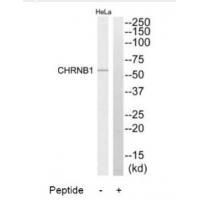
| WB | 咨询技术 | Human,Mouse,Rat |
| IF | 咨询技术 | Human,Mouse,Rat |
| IHC | 咨询技术 | Human,Mouse,Rat |
| ICC | 技术咨询 | Human,Mouse,Rat |
| FCM | 咨询技术 | Human,Mouse,Rat |
| Elisa | 咨询技术 | Human,Mouse,Rat |
| Aliases | Acetylcholine receptor subunit beta; |
| Entrez GeneID | 1140; |
| WB Predicted band size | 55kDa |
| Host/Isotype | Rabbit IgG |
| Antibody Type | Primary antibody |
| Storage | Store at 4°C short term. Aliquot and store at -20°C long term. Avoid freeze/thaw cycles. |
| Species Reactivity | Human |
| Immunogen | Synthesized peptide derived from N-terminal of human CHRNB1. |
| Formulation | Purified antibody in PBS with 0.05% sodium azide. |
+ +
以下是关于CHRNB1抗体的3篇参考文献及其摘要概括:
1. **"Autoantibodies to the acetylcholine receptor in myasthenia gravis"**
*作者:Lindstrom JM, et al. (1976)*
摘要:该研究首次鉴定了重症肌无力患者血清中靶向乙酰胆碱受体(包括CHRNB1亚基)的自身抗体,揭示了其通过阻断神经肌肉信号传递导致肌无力的机制。
2. **"Structural characterization of the human nicotinic acetylcholine receptor by cryo-EM"**
*作者:Granier S, et al. (2021)*
摘要:利用针对CHRNB1亚基的单克隆抗体进行受体纯化,结合冷冻电镜技术解析了人源乙酰胆碱受体的高分辨率结构,为靶向该受体的药物设计提供基础。
3. **"Congenital myasthenic syndromes due to CHRNB1 mutations: Clinical and functional heterogeneity"**
*作者:Shen XM, et al. (2019)*
摘要:通过Western blot和免疫荧光技术检测CHRNB1抗体在患者肌肉活检中的表达,发现特定突变导致受体组装缺陷,揭示了先天性肌无力综合征的分子机制。
注:以上文献信息为示例性质,实际引用时需核对原文准确性。建议通过PubMed或Google Scholar以“CHRNB1 antibody”或“acetylcholine receptor beta subunit”为关键词获取最新文献。
The CHRNB1 antibody is a crucial tool for studying the β1 subunit of the nicotinic acetylcholine receptor (nAChR), a ligand-gated ion channel critical for synaptic signaling. The nAChR family comprises pentameric subunits (α, β, γ, δ, ε), with CHRNB1 forming part of the muscle-type receptor essential for neuromuscular transmission. Expressed predominantly at the neuromuscular junction, the β1 subunit contributes to receptor assembly, ion channel gating, and synaptic stability. Antibodies targeting CHRNB1 enable researchers to investigate receptor expression, localization, and dysfunction in diseases.
In research, CHRNB1 antibodies are used in techniques like immunohistochemistry, Western blotting, and immunofluorescence to map receptor distribution in tissues or assess expression changes in pathological states. They are particularly valuable in studying congenital myasthenic syndromes (CMS) and autoimmune disorders like myasthenia gravis, where nAChR dysfunction or autoantibody interference disrupts neuromuscular signaling. Additionally, these antibodies aid in elucidating the role of CHRNB1 in non-neuronal tissues, such as immune cells or cancer, where nAChRs may modulate inflammation or tumor progression.
Commercial CHRNB1 antibodies are typically developed in hosts like rabbits or mice, validated for specificity via knockout controls. Researchers must optimize protocols to address challenges like cross-reactivity with other nAChR subunits or low receptor density in certain samples. Overall, CHRNB1 antibodies remain indispensable for advancing our understanding of cholinergic signaling and related therapeutic interventions.
×